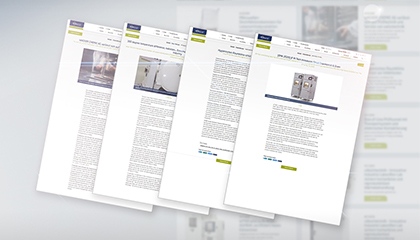Ascott Analytical Equipment Limited
6 – 8 Gerard, Lichfield Road, Lichfield Road Industrial Estate Tamworth, Staffordshire, B79 7UW, イギリス
sales@ascott-analytical.com
Schunk do Brasil Eletrografites Ltda.
Divisão Weiss, Estrada do Embu, 2777 Bairro Moinho Velho 06713-100 Cotia - SP, ブラジル
sales.br@weiss-technik.com
詳細を見る
Weiss Klimatechnik GmbH
Greizer Straße 41-49, 35447 Reiskirchen-Lindenstruth, ドイツ
info@weiss-technik.com
詳細を見る
Weiss Pharmatechnik GmbH
Georg-Bölts-Straße 2-8, 26135 Oldenburg, ドイツ
info.pharma@weiss-technik.com
詳細を見る
Weiss Technik AG Switzerland
Brügglistraße 2, 8852 Altendorf, スイス
info.ch@weiss-technik.com
詳細を見る
Weiss Technik Belgium B.V.
Nijverheidszone, Begijnenmeers 63, 1770 Liedekerke, ベルギー
sales.be@weiss-technik.com
詳細を見る
Weiss Technik France S.A.S.
2-4, allée Jacques Latrille, 33650 Martillac, France, フランス
info.fr@weiss-technik.com
詳細を見る
Weiss Technik France S.A.S.
Parc @robase - 73, avenue du Gros Chêne, CS 90253 Eragny, 95615 Cergy Pontoise Cedex, フランス
info.fr@weiss-technik.com
詳細を見る
Weiss Technik GmbH
Greizer Straße 41-49, 35447 Reiskirchen-Lindenstruth, Germany, 韓国
info@weiss-technik.com
Weiss Technik GmbH, Balingen
Beethovenstraße 34, 72336 Balingen-Frommern, ドイツ
info@weiss-technik.com
詳細を見る
Weiss Technik GmbH, Reiskirchen
Greizer Straße 41-49, 35447 Reiskirchen-Lindenstruth, ドイツ
info@weiss-technik.com
詳細を見る
Weiss Technik GmbH, Wärmetechnik
Greizer Straße 41-49, 35447 Reiskirchen-Lindenstruth, ドイツ
info@weiss-technik.com
詳細を見る
Weiss Technik India Private Limited
Legend – Gold Leaf Premises 3/A, 3rd Floor H.No: 3-4-559 to 3-4-566, Narayanaguda, Hyderabad -500029, インド
sales.in@weiss-technik.com
詳細を見る
Weiss Technik Italia S.r.l.
Via R. Murri, 22/28, 20013 Magenta(MI), イタリア
info.it@weiss-technik.com
詳細を見る
Weiss Technik Malaysia Sdn Bhd
1-1-6 & 1-1-7, Tingkat Mahsuri 2 1 Sky, 11950 Bayan Lepas, Penang, マレーシア
ralf.touby@weiss-technik.com
Weiss Technik Mexico, S.A. de C.V.
Calle Acueducto del Alto Lerma No. 6 – B Corredor Industrial, Ocoyoacac, Estado de México, メキシコ
contabilidad.mx@weiss-technik.com
詳細を見る
Weiss Technik Mexico, S.A. de C.V. (Guadalajara)
Benjamin Gutiérrez 3963, Col. Rancho Nuevo CP: 44240 Guadalajara, Jalisco México, メキシコ
ventas.mx@weiss-technik.com
詳細を見る
Weiss Technik Nederland B.V.
Newtonstraat 5, 4004 KD Tiel, オランダ
info.nl@weiss-technik.com
詳細を見る
Weiss Technik North America Inc. Sales CSZ products
12011 Mosteller Road Cincinnati, OH 45241, アメリカ合衆国
sales@cszproducts.com.
詳細を見る
Weiss Technik North America Inc. Sales Weiss Technik products
3881 N. Greenbrooke S.E., Grand Rapids, MI 49512, アメリカ合衆国
sales.na@weiss-technik.com
詳細を見る
Weiss Technik Singapore Pte. Ltd.
No. 68 Kallang Pudding Road, #03-04 SYH Logistics Building 349327, シンガポール
ralf.touby@weiss-technik.com
詳細を見る
Weiss Technik Thailand Ltd.
899/19 Moo21, Tumbol Bangpleeyai, Amphur Bangplee, Samutprakarn 10540, タイ
ralf.touby@weiss-technik.com
詳細を見る
Weiss Technik UK Ltd.
Units 37-38, The Technology Centre, Epinal Way, Loughborough, Leics. LE11 3GE, イギリス
enquiries.gb@weiss-technik.com
詳細を見る
Weiss Umwelttechnik Ges.m.b.H.
Oberlaaerstraße 316, 1230 Wien, オーストリア
info.at@weiss-technik.com
詳細を見る
Weiss-Voetsch Environmental Testing Instruments (Taicang) Co., Ltd.
No.102 Changsheng Road, Kaiming Industry Park, Taicang, Jiangsu Province, 215400 P.R., 中国
info.cn@weiss-technik.com
詳細を見る
weisstechnik Academy
Greizer Straße 41-49, 35447 Reiskirchen-Lindenstruth, ドイツ
academy@weiss-technik.com

